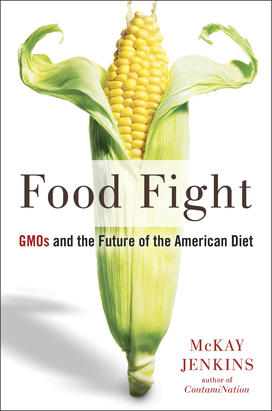McKay Jenkins *96 Crosses the Battle Lines of the GMO Debate

Investigative journalist McKay Jenkins *96 starts Food Fight: GMOs and the Future of the American Diet (Avery) with the question on many readers’ lips: Are GMOs (Genetically Modified Organisms) safe? GMOs, which have recently garnered many headlines, are found in the vast majority of the 40,000 food products in American grocery stores, and constitute 85 percent of feed consumed by chickens and cattle. Their detractors have dubbed them “Frankenfoods” for the way they’ve fiddled with plants’ genetic codes, and fear they are irreversibly altering our food supply in unsafe ways.
The real issue isn’t whether GMOs are dangerous, McKay insists, but whether they’ve made our diets unhealthy. “Scientists are close to uniform in the belief that GMOs are safe,” McKay says. “On the other hand, the vast majority of GMO foods are found in fast food and cheap, industrially grown meat.” While GMOs didn’t engender the industrialization of agriculture, they have allowed for an enormous scaling up, with 320 million acres of monoculture corn and soybeans in the Midwest providing most of our American diet. Jenkins explores the consequences of that history eschewing alarmism and taking an objective approach to the topic.
As a Ph.D student in English at Princeton, after 10 years as a reporter at The Seattle Times and the Atlanta Journal-Constitution Jenkins sought out Ferris Professor of Journalism John McPhee in order to learn the trade of long-form journalism.
“I was just so pleased to be in his presence,” says Jenkins. “I have always been a fan of McPhee’s ability to write about controversial issues with a trustworthy voice.” After graduating from Princeton, Jenkins has tackled a number of controversial topics himself, including toxic chemicals in everyday objects, and chemical companies’ corruption of the Environmental Protection Agency.
That’s certainly the case in Food Fight. Though it’s unsparing in holding chemical companies accountable, the book also explores the many ways in which GMOs have helped people. In Hawaii, for example, a Stanford researcher developed a strain of papaya resistant to the green spot virus, singlehandedly saving an entire industry. In Africa, a nonprofit research group has developed a strain of cassava that is resistant to drought and fortified with B-vitamins to help combat starvation. “The technology can be a tool used by big corporations to promote bad, unhealthy, low-nutrition food, or can be used by nonprofits and university researchers to find ways to solve significant health and environmental problems,” says Jenkins.
On the other side, Jenkins explores how GMOs are often developed hand-in-hand with pesticides and herbicides designed specifically for use with a particular type of crop, leading to increased chemical contamination that causes environmental damage. In the best-known example, Monsanto’s Roundup herbicide has decimated the milkweed crop upon which Monarch butterflies depend, bringing their population down to 4 percent of what it was a few decades ago.
Jenkins ends the book by empowering readers with information to make their own decisions about how to support a healthier food system. Rather than just protesting GMOs, he suggests, consumers need to become savvier about how GMOs have led to unhealthy, industrially produced food, and vote with their pocketbooks to seek out alternatives. “It’s very easy to blame companies for bad food, but consumers can choose not to eat it if they pay attention to where it’s coming from,” he says. “My biggest hope is that we can learn to grow food more sustainably, and it’s possible that GMOs can be part of that solution.”












2 Responses
Robert E. “Bob” Buntrock *67
8 Years AgoAgreed. Not much milkweed...
Agreed. Not much milkweed grows in corn fields, although possibly next to them. Destruction of milkweed habitat occurs more via development of open fields and meadows, for housing and commercial development.
The last paragraph is also unnecessarily pejorative and shows biased responses to what should have been an in-depth study. Also no mention of newer, targeted gene-transformation processes that promise to be very beneficial and should not be lumped in with the earlier processes.
Robert Howd
8 Years AgoI don't think it's...
I don't think it's appropriate to claim that use of Roundup is solely responsible for the decline in Monarch butterflies. Yes, improved weed control in increased monoculture acreage has decreased milkweed, but habitat loss in Mexico, the winter refuge of a major part of the Monarch population, has also played an important part in the decline.